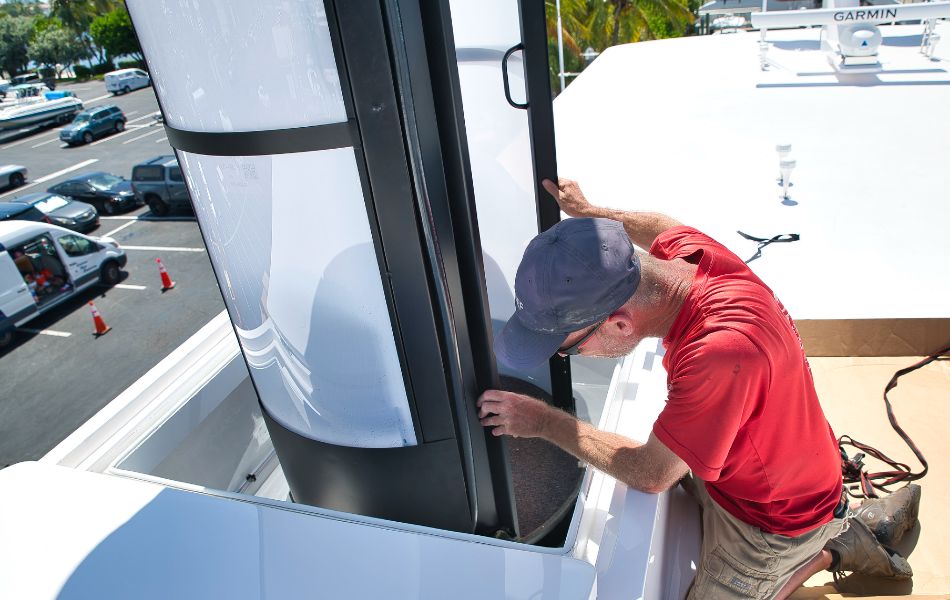Elevators are an essential part of modern life, transporting people and goods vertically in buildings. But have you ever wondered how much weight an elevator can safely hold? This seemingly simple question has a complex answer, and understanding elevator weight limits is crucial for both passengers and building managers.
This comprehensive guide delves into everything you need to know about elevator weight limits. We’ll explore the factors that determine capacity, safety implications of exceeding limits, and best practices for ensuring safe elevator usage.
By the end of this article, you’ll be well-equipped to:
- Identify the weight limit of an elevator.
- Understand the consequences of overloading.
- Practice safe elevator etiquette for optimal operation.
Factors Affecting Elevator Weight Capacity

Elevator weight capacity isn’t a one-size-fits-all number. Several factors influence how much weight an elevator can safely handle:
- Elevator Design and Construction: Larger elevators with sturdier materials naturally have higher capacities.
- Purpose and Location: Elevators in commercial buildings designed for high traffic typically have higher capacities than those in residential buildings.
- Number of Passengers: The average weight of passengers is factored into the design.
- Cargo Capacity: Freight elevators are built for heavier loads than passenger elevators.
- Lifting Mechanism: Hydraulic and traction elevators have different weight limitations.
Typical Elevator Weight Ranges

While the exact weight limit varies depending on the factors mentioned above, here’s a general breakdown of typical elevator capacities:
- Residential Elevators: 500 lbs – 1,500 lbs (Suitable for a small family or individual use)
- Commercial Passenger Elevators: 2,500 lbs – 5,000 lbs (Accommodates multiple passengers with luggage)
- Freight Elevators: 5,000 lbs – 10,000 lbs (Designed for heavy loads like furniture or building materials)
Finding the Weight Limit: It’s Easier Than You Think
There are several ways to determine the weight limit of a specific elevator:
- Weight Capacity Plate: Look for a metal plate inside the elevator cab that clearly displays the maximum weight capacity.
- Building Directory or Signage: Building management may post the weight limit information near the elevator entrance.
- Contact Building Management: If you can’t locate the weight limit information, don’t hesitate to contact building management for clarification.
Consequences of Exceeding Elevator Weight Limit
Ignoring elevator weight limits can have serious consequences:
- Safety Hazards: Overloaded elevators put undue stress on the motor, cables, and other components, increasing the risk of breakdowns and potential passenger injuries.
- System Strain: Exceeding weight limits can lead to premature wear and tear on the elevator system, resulting in expensive repairs and downtime.
- System Shutdown: Modern elevators have built-in safety features that may disable the elevator if the weight limit is exceeded, causing inconvenience and potential delays.
Sharing the Ride: Elevator Etiquette for Optimal Weight Distribution
Here are some best practices for ensuring safe and efficient elevator usage:
- Be Mindful of Weight: Estimate the weight of your belongings and avoid overloading the elevator, especially with large or heavy items.
- Wait for the Next One: If the elevator seems full, consider waiting for the next one to avoid exceeding the weight limit.
- Distribute Weight Evenly: Passengers should distribute themselves evenly within the elevator car to avoid overloading a specific corner.
- Use Common Sense: If you have bulky items, assess if they can be comfortably accommodated in the elevator without exceeding the capacity.
- Communicate with Others: If you have particularly heavy items, politely communicate with other passengers to see if they’d be willing to wait for the next elevator.
Special Considerations: Specific Situations and Weight Limits
Here are some specific situations where weight limits might be a concern:
- Moving Day: During moves, carefully plan and distribute the weight of boxes and furniture across multiple elevator trips to stay within the weight limit.
- Using a Stretcher: Hospitals and healthcare facilities may have elevators with higher weight capacities to accommodate stretchers and medical equipment.
- Fire Evacuation: Elevator weight limits may be temporarily disregarded during emergencies like fire evacuations to prioritize occupant safety. However, always follow instructions from building officials.
Maintenance Matters: Ensuring Optimal Elevator Performance
Regular maintenance is crucial for ensuring that elevators operate safely and efficiently within their weight limits. Building managers should:
- Schedule Regular Inspections: Qualified elevator technicians should perform routine inspections to identify potential issues and ensure proper operation of weight-bearing components like cables and brakes.
- Adhere to Maintenance Schedules: Follow the manufacturer’s recommended maintenance schedule for the specific elevator model to maintain optimal performance and capacity.
- Conduct Load Testing: Periodic load testing helps verify the elevator’s ability to handle its designated weight limit and identify any potential capacity reductions due to wear and tear.
- Invest in Modernization: Older elevators may have lower weight limits compared to current standards. Upgrading elevator components or replacing the entire system can improve capacity and safety features.
Technological Advancements: The Future of Elevator Weight Limits
The world of elevators is constantly evolving, with advancements in technology impacting weight limits:
- Lightweight Materials: The use of lighter yet stronger materials in elevator construction allows for increased weight capacities without compromising safety.
- Smart Elevator Systems: Modern elevator control systems utilize sensors and real-time weight monitoring to optimize passenger loading and prevent overloading.
- Machine Room-less (MRL) Elevators: These space-saving elevators often have higher weight capacities due to more efficient motor placement and design.
Legal Landscape: Regulations and Weight Limits
Elevator weight limits are not simply recommendations; they are legal requirements enforced by building codes and safety regulations. These regulations vary depending on location and building type. Common regulatory bodies include:
- American Society of Mechanical Engineers (ASME) A17.1 Safety Code for Elevators and Escalators
- International Organization for Standardization (ISO) Standards
Conclusion: Sharing the Ride Responsibly
Understanding and respecting elevator weight limits is a shared responsibility between passengers and building management. By working together, we can ensure safe, efficient, and reliable elevator usage for everyone. Passengers should be mindful of their weight and belongings, while building managers should maintain the elevator system and clearly communicate capacity information. By following these guidelines, we can ensure a smooth and safe ride for all.
Remember: Always prioritize safety. If you are unsure about the weight limit or have concerns about overloading, err on the side of caution and wait for the next elevator.
Frequently Asked Questions (FAQs) About Elevator Weight Limits
Here are some of the most frequently asked questions regarding elevator weight limits:
General Questions
- Where can I find the weight limit of an elevator?
The weight limit of an elevator is typically displayed on a metal plate inside the elevator car. You can also find it in building directories or signage near the elevator entrance. If you can’t locate it, don’t hesitate to contact building management.
- What happens if I overload an elevator?
Exceeding the weight limit can put strain on the elevator’s motor, cables, and other components, increasing the risk of breakdowns and potential injuries. Additionally, safety features might disable the elevator, causing inconvenience and delays.
- Is it okay to go slightly over the weight limit?
It’s best to avoid exceeding the weight limit altogether. Even a slight overload can put stress on the system. When in doubt, wait for the next elevator.
- How much does the average person weigh for elevator capacity calculations?
Most elevator capacities are based on an average passenger weight of 150-200 pounds (68-91 kg).
- What are the weight limits for different types of elevators?
- Residential elevators: 500 lbs – 1,500 lbs (Suitable for a small family or individual use)
- Commercial passenger elevators: 2,500 lbs – 5,000 lbs (Accommodates multiple passengers with luggage)
- Freight elevators: 5,000 lbs – 10,000 lbs (Designed for heavy loads like furniture or building materials)
Specific Situations
- What should I do on moving day when I have a lot of heavy items?
Plan your move carefully. Distribute the weight of boxes and furniture across multiple elevator trips to stay within the weight limit. Consider using a freight elevator if available for bulky items.
- Do elevators in hospitals have a higher weight limit?
Hospitals and healthcare facilities may have elevators with higher weight capacities to accommodate stretchers and medical equipment. Always check the posted weight limit or consult with staff.
- Can I use an elevator during a fire evacuation if it’s overloaded?
Elevator use during emergencies like fire evacuations is typically discouraged due to potential malfunctions. However, building officials may prioritize occupant safety and allow temporary disregard for weight limits. Always follow instructions from fire wardens or building officials.
Weight Limits and People
- What if I am overweight, can I still use the elevator?
Of course! Elevators are designed to accommodate a variety of weights. As long as the total weight doesn’t exceed the limit, you can safely use the elevator.
- I’m traveling with a group. How can we ensure we don’t overload the elevator?
Estimate the combined weight of your group and belongings. If unsure, split into smaller groups and take multiple elevator trips.
- What if someone refuses to get off the elevator when it seems overloaded?
Politeness is key. You can politely explain the weight limit and suggest they wait for the next elevator. If the situation escalates, consider contacting building management.
Weight Limits and Cargo
- Can I bring a stroller or wheelchair on the elevator?
Absolutely! Most elevators are designed to accommodate strollers and wheelchairs. However, if you have a particularly bulky stroller or electric wheelchair, check its weight beforehand and ensure it doesn’t overload the elevator with other passengers.
- What about large furniture or appliances?
For large items like furniture or appliances, assess if they can fit comfortably within the elevator without exceeding the capacity. If unsure, consider using a freight elevator or contacting building management for assistance.
- Can I bring a bicycle on the elevator?
Some buildings may allow bicycles on passenger elevators, while others might have designated freight elevators for such purposes. Always check building guidelines or signage before bringing a bicycle on the elevator.
- Who is responsible for enforcing elevator weight limits?
Building management is ultimately responsible for ensuring safe elevator usage and enforcing weight limits. However, passengers also play a role in being mindful and avoiding overloading.








